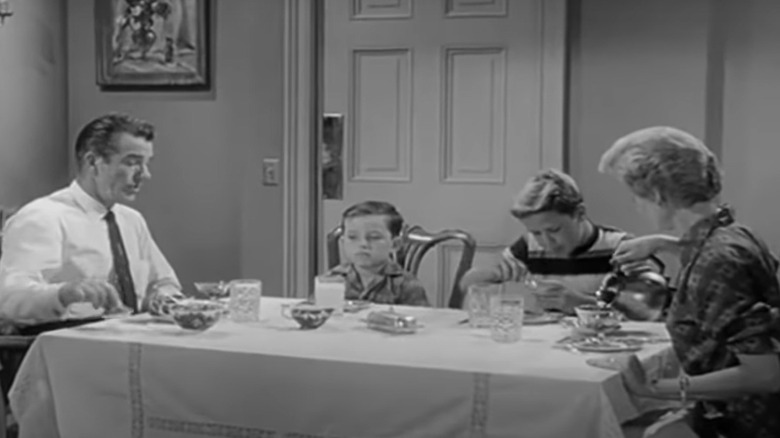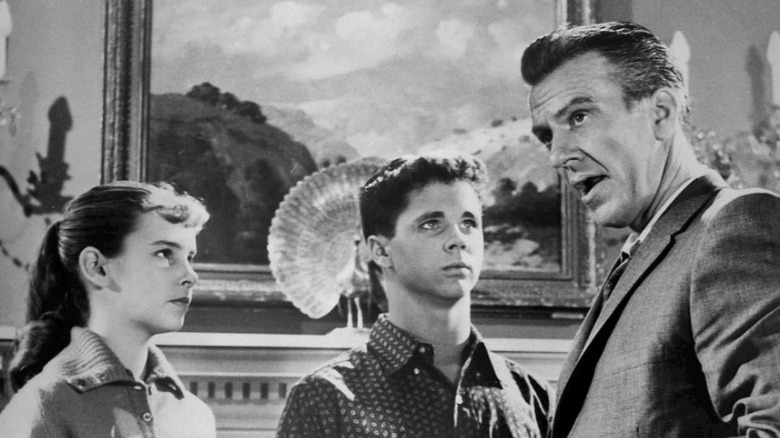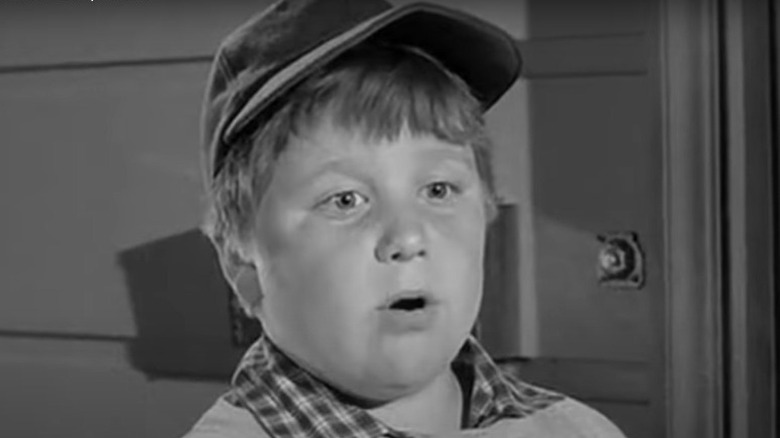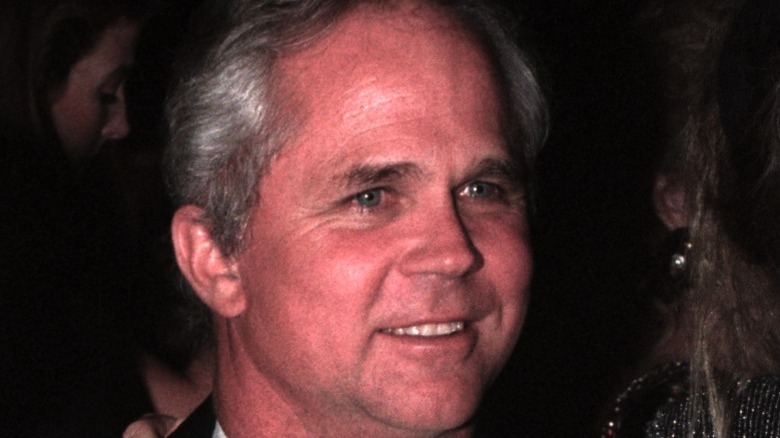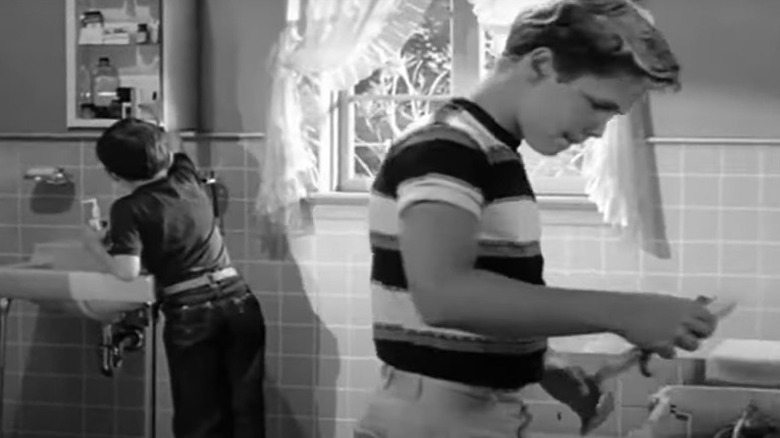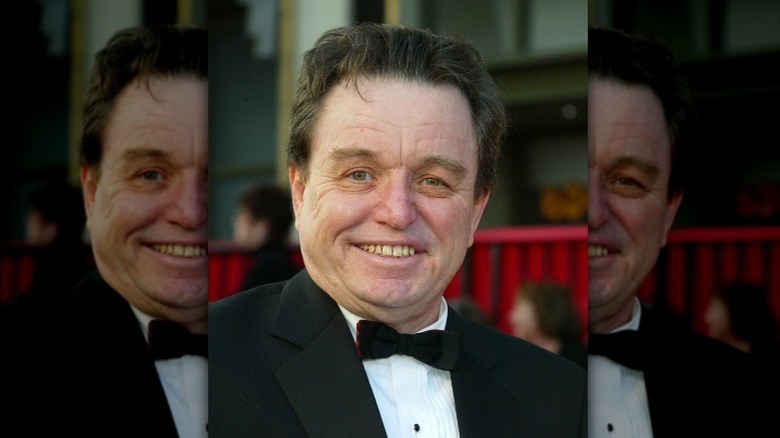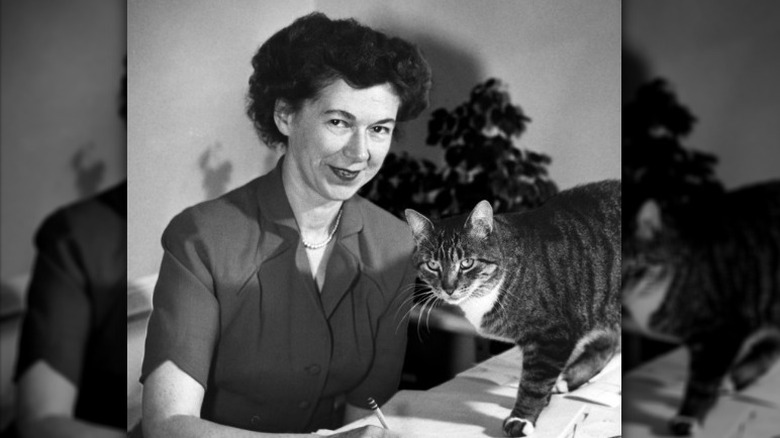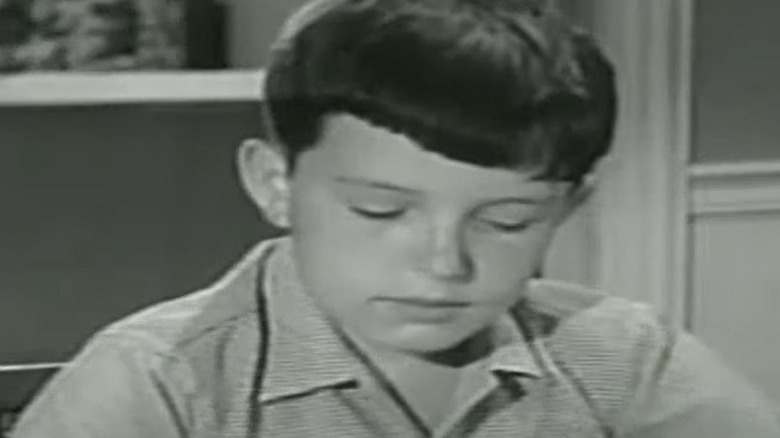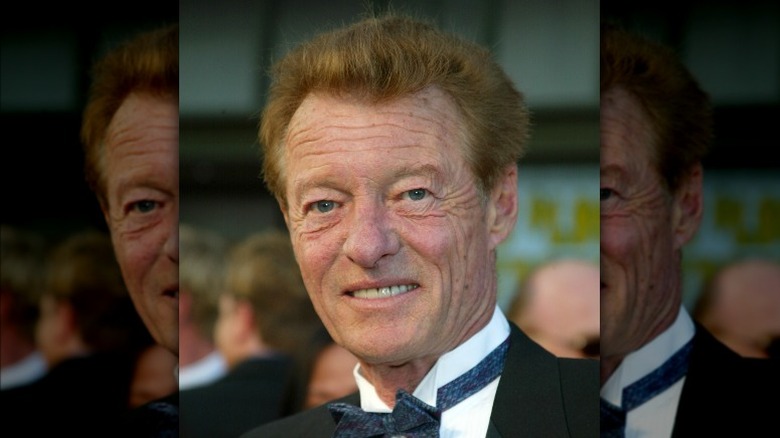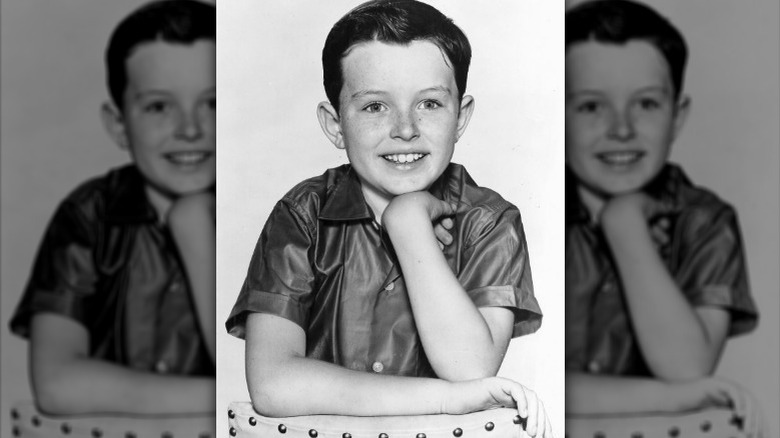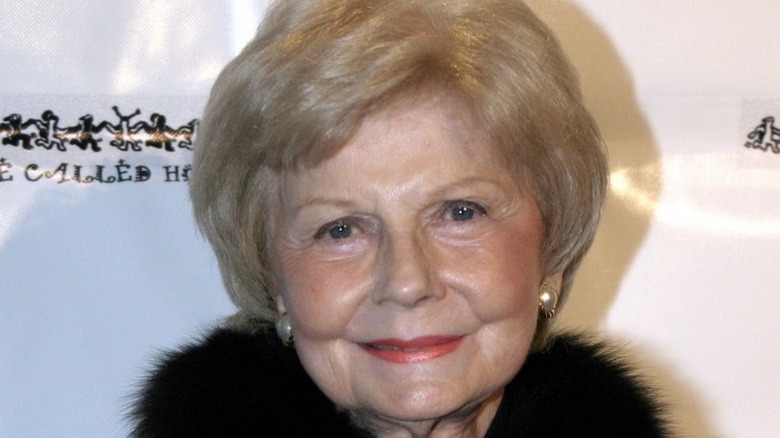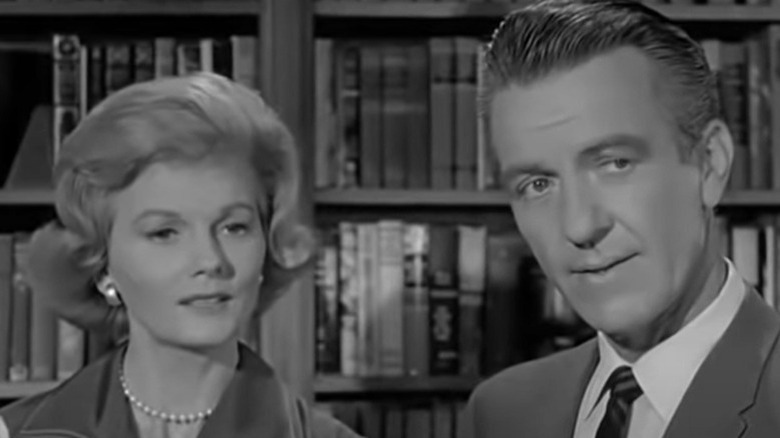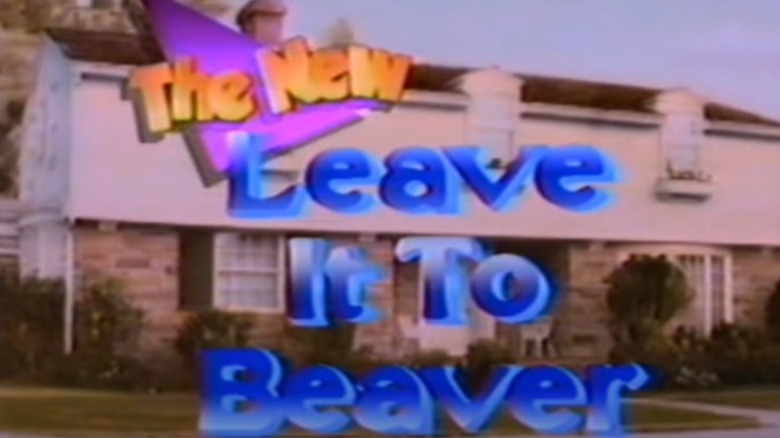The Untold Truth Of Leave It To Beaver
There are only a handful of shows from the golden era of television that are still widely known by audiences more than half a century later. Among American adults, you'd probably be hard-pressed to find someone that hadn't at least some familiarity with "I Love Lucy," "Gunsmoke," or "Alfred Hitchcock Presents." Television then, like now, had shows that spanned all genres of interest, ranging from suspense to comedy to Western action/dramas.
Shows that centered around family life were also a dominant staple of that era. The decade of the 1950s certainly had its hits in this category, with shows like "Father Knows Best" and "The Adventures of Ozzy and Harriet" both garnering multiple Emmy nominations and earning high shares of viewers during their respective runs in black and white.
Perhaps the family-centered sitcom that will always be attributed to TV's golden era is "Leave it to Beaver." The show ran over six seasons producing a monumental 236 episodes, each one capturing a pseudo-realistic glimpse into the lives of a "typical" 1950s suburban family.
There are several fascinating tidbits about the show that even the most devoted fans might not be aware of. But cognizant of the truth or not, each of these helped mold the show into what it was and into how it would always be remembered.
Many of the episodes were directed by Hugh Beaumont
Hugh Beaumont was a veteran of the small screen when he was cast in the role of the family patriarch as Ward Cleaver. An actor who began his entertainment career on stage and radio, he began acting in films in 1940 and made the jump to television with a spot in the 1952 show "Personal Appearance Theater," as his IMDb credits note. From there, he appeared in dozens of shows before landing the part he would be forever known for in "Leave it to Beaver" in 1957.
But Beaumont was more than just an accomplished actor. Outsider tells us that Beaumont was also working on the other side of the camera throughout the series, serving as the director of 23 episodes.
Beaumont was also a writer. Though he only had one screenwriting credit before his tenure on "Leave it to Beaver" (he wrote an episode of "The Loretta Young Show" in 1953), he officially penned an episode for the Cleaver family in 1959, though Outsider states that he wrote many others without credit.
The actor's post-Ward Cleaver career included more TV appearances, as he was cast in parts for "Mannix," "Petticoat Junction," and others until he retired from acting in the early '70s. He died in 1982, a year before the Cleaver family made their TV comeback with a sequel series "The New Leave it to Beaver."
Rusty Stevens, who played Larry Mondello, was written out of the show because of his mom
"Leave it to Beaver" had a good number of minor characters that became almost as well known as the central figures in the sitcom. Most of these roles were played by children and teenagers, whose characters were the friends (and sometimes adversaries) of Wally and Beaver Cleaver.
Perhaps the most well-known among young Beaver's friends was a portly little fellow named Larry Mondello, played by Rusty Stevens. Young Larry was constantly henpecked by his mother, which often worked its way into episode plots. Like many of the other children the Cleaver boys were pals with, Larry would sometimes talk his friend into getting into mischief that would lead to the Beav getting a lecture from Ward Cleaver in the family's den. It was Larry who convinced Beaver to smoke his father's collectible Meerschaum pipe in the episode "The Pipe" and who also talked the lad into breaking into Principal Cornelia Rayburn's office to see her legendary "spanking machine" in the episode "Price of Fame."
Though appearing in nearly 70 episodes of the show, Larry Mondello was unceremoniously written out of the series after 1960. Barbara Billingsly, who played June Cleaver in the show, cast some light on the mystery. In an interview before her death, she claimed that Stevens' mother badgered producers so much that they were forced to cancel young Stevens' part in the show (per Television Academy). She claimed his mother was a problematic stage mom, and the crew was tired of dealing with her.
The show's pilot did not have Tony Dow or Hugh Beaumont cast
Years after it first aired, the long-lost "Leave it to Beaver" pilot was finally unearthed and was shown to a new generation of audiences. Before the episode was rediscovered in the 1980s, it was feared that it was gone forever. The episode, titled "It's a Small World," served as a season three episode of "Studio 57," a dramatic anthology series, before soon becoming its own show with name of "Leave it to Beaver." The Paley Center for Media reports that the rediscovered show was aired for the first time in 30 years on October 4, 1987, as a special for "The New Leave it to Beaver."
Longtime fans of the show quickly noted some major differences between the pilot and the show that it became. The lack of a laugh track was immediately evident, as per The Dallas Morning News, but perhaps not as much as two missing familiar faces from the show's storied run.
You won't find actors Tony Dow or Hugh Beaumont in the pilot. Wally Cleaver's part was played by Paul Sullivan, with the part of the patriarch cast by veteran actor Max Showalter. In her interview with the Television Academy, Barbara Billingsly recalls how Sullivan grew too fast after the pilot was shot, making him appear older than the Wally Cleaver the producers wanted on the series.
Leave it to Beaver was the first TV show to show a toilet tank
The standards and practices that network television censors abided by during this era seem a bit ridiculous by modern standards. Married couples were never shown in the same bed, and the mere mention of sex was taboo enough to keep a lot of material considered tame by today's world omitted from scripts altogether in the 1950s.
Network censors even took issue with certain parts of our homes being shown on TV in those days. One such fixture that was forbidden to be on screen was the household toilet. As the Saturday Evening Post details, what was to be the first episode of the "Leave it to Beaver" series had to be delayed, because the toilet in the bathroom that Wally and Beaver Cleaver shared was integral to the plot. When it was aired, the "Captain Jack" episode became one of the most memorable of the series and did include the toilet tank and the baby alligator that the boys kept inside it.
Wally and Beaver had ordered the reptile from a comic book ad and were using the toilet tank for its aquarium, keeping it from the prying eyes of Ward and June Cleaver. Eventually, it grows too big for its makeshift home, and the boys place it in a basement tub where it is discovered by Ward (spoiler alert: Ward gets his hand bitten by the little guy).
The show proved to be a merchandizing cash cow
When a show is a hit, you seem to see the faces of the characters everywhere you look. Whether a likeness of popular show characters is on posters, toys, lunchboxes, or any other wide assortment of products (anyone remembers "Mr. T" cereal?), it's sure to capture the interest of fans and some newbies. Some might be surprised that this marketing strategy was there before television and certainly played a part in capitalizing on viewers' interests in certain shows.
"Leave it to Beaver" had such a success with audiences that it became a cash cow for the network, which authorized board games, coloring books, and more featuring young Jerry Mathers. All American Speakers reports that Mathers was the first child actor to ever receive a cut from merchandising revenue and tells us that "Leave it to Beaver" still generates revenue for the star today, from new merchandising created for fans.
The show launched a book series
Along with multiple products being sold with Jerry Mather's likeness, the show was also able to launch a successful children's book series. The three books were released beginning in 1960 and featured an up-and-coming children's author who was quickly becoming a household name on her own.
As Outsider details, Beverly Cleary wrote "Leave it to Beaver," "Beaver and Wally," and "Here's Beaver," a mere 10 years after she wrote her first book "Henry Huggins." Long before she would be known for her Newberry honor-winning "Ramona Quimby" books (via National Endowment for the Arts), Cleary was busy penning the antics of Beaver and his older brother Wally. Each book served as a series of short stories, most of which came from the aired episodes of the show.
Cleary would go on to write more than 30 books for children, selling 91 million copies of her works worldwide (via Newsweek).
Every episode was based on a true story
It's often said that truth is stranger than fiction. This adage was proven time and time again with the long run of "Leave it to Beaver," as it was revealed that every episode was based on a real-life mishap that was experienced by the show's producers or writers.
In her interview with the American Television Academy, Barbara Billingsly recalled how the plotlines were directly from events that had happened to producers Joe Connelly and Bob Mosher or people known to them. "I think that's what makes the show reflect its real quality," she said.
Whether it was the boys being disappointed in getting umbrellas as a gift, or Beaver getting a traffic ticket for driving his go-kart in the street by a police officer, Billingsly insists that those and other situations written in the scripts were not the product of imagination but were Connelly's and Mosher's way of taking their real-life situations and making it relatable for audiences.
In a 2013 interview with My Prime Time News, Jerry Mathers confirms Billingsly's claims, stating that "most of the significant themes were based on truth, driven by real stories that were shared with the show's writers, producer, and director."
Eddie Haskell was only supposed to be on one episode
Beaver Cleaver wasn't the only character on the show to have friends that got him into mischief. His elder brother Wally Cleaver had more than his fair share of chums that had a way of talking the usually level-headed Cleaver son into getting into embarrassing situations. Of all the teen boys Wally claimed as pals, there is none more universally known as Eddie Haskell.
Haskel put up a convincing front as the apple-polishing brown noser, going overboard with compliments to adults (especially mothers) all the while scheming to hatch a plot that would end up with Wally getting an inevitable lecture or punishment by the end of the episode.
But while Haskell, played by Ken Osmond, made nearly 100 appearances on "Leave it to Beaver" (per IMDb), he was only supposed to have been a one-off character. The Hollywood Reporter reports that Osmond so impressed the powers that be with his role in the fifth episode of the series that they wound up writing him into the show as a regular character. It's hard to imagine the series without the perpetual "wise guy," who would later be revived in the series sequel in the 1980s.
Jerry Mathers wore his scout uniform to his audition
Before being cast as Beaver, Jerry Mathers had appeared in several television shows and films. He acted in an early episode of "The Adventures of Ozzy and Harriet," as well as in the 1955 Alfred Hitchcock flick "The Trouble with Harry" (via IMDb).
When he was brought into the casting call for the role of the Beaver, Mathers was around 7 years old. In a 2007 interview with Parade Magazine, Mathers recalls how the audition went, and how his choice of dress might have influenced network brass into giving him the role he will forever be known for.
According to Mathers, he had just joined the Cub Scouts and had his first meeting that evening. Anxious that the audition was taking too long, he was distracted and fidgety, prompting a casting director to ask him, "Why are you so fidgety, Jerry?" to which he replied, "I don't want to be here because I have a Cub Scout meeting."
Mathers goes on to say that his mom later remarked to him that it "probably wasn't the best thing to tell them." But the producers phoned her later that night and informed her that Mathers was their choice for the role of Beaver. What persuaded them to make that decision? Mathers revealed that she was told that the reason he was picked was that "they'd rather have a child that wanted to go to a Cub Scout meeting than to be an actor."
June Cleaver's iconic pearls concealed an issue producers didn't like about the actress' neck
June Cleaver seemed to always be on screen wearing heels and a set of pearls. The running joke was that she looked more put together at home in the 1950s than many adults do on the job. And while her character's choice of attire might not have been realistic even by 1950s standards, there was a reason why she was always draping her neck with a strand of pearls.
Barbara Billingsly discusses her necklace in her interview with the American Television Academy and reveals to viewers that the producers felt her body had something that needed to be concealed. When asked by the interviewer about the necklace, Billingsly sighs and says, "I'm going to say this one more time. I have a hollow," and she then goes on to touch a place on her neck, that would oftentimes cast an unwanted shadow. Though there were rumors of the necklace being used to cover up a nasty scar, Billingsly sticks to her story and says that it's the "gospel truth."
As for those high heels, Billingsly says that she wore flats in the early episodes but needed to switch to heels to give her the appearance of being taller than her on-screen sons. They kept growing, making those added inches to her height even more important.
Leave it to Beaver set a precedent for having a series finale
Long-running shows have a set standard of having a finale to wrap it all up. The final episodes give networks one last shot at tying up loose ends from plot lines, as well as a mechanism for selling ad revenue in what is usually well-anticipated and heavily viewed segments on prime-time TV.
The last episode of "Leave it to Beaver" found the Cleaver family crowding around a family photo album June Cleaver discovered when cleaning out a cabinet. Titled "Family Scrapbook," the Hugh Beaumont-directed episode served as a clip show, with each photo the family reminiscing over leading into a scene from a previously run show.
According to Outsider, the series finale of the show was the first of its kind to utilize the clip-show technique at the end of a program's run, setting a standard that many subsequent productions have followed to this day.
Tony Dow and Jerry Mathers pitched a show sequel idea to networks for years
Tony Dow and Jerry Mathers remained good friends after "Leave it to Beaver" ran its course. The pair began acting together again in the late 1970s, but this time on stage instead of on the small screen. The Washington Post reports that they co-starred in a production of "Boeing, Boeing" in 1978 and followed up with a stage play written specifically for the two actors, titled "So Long, Stanley" in 1979.
The news outlet also revealed that Dow and Mathers had been trying to get executives from the different networks to create a show based on the Cleaver family. Their idea was to have a new series that followed the lives of Wally and Beaver Cleaver as adults, dealing with parenting their respective children. Surprisingly, networks passed on the premise, prompting Dow to remark that "the networks have no idea what drawing power we have."
Several years later, CBS bit with "Still the Beaver," a made-for-TV movie that served as the pilot episode for "The New Leave it to Beaver" show. The sequel series was picked up by The Disney channel and later TBS, running from 1983 until its finale in 1989 (per IMDb). The series featured Dow, Barbara Billingsly, and Mathers, and also brought back the characters Clarence "Lumpy" Rutherford and Eddie Haskell, played by the original actors Frank Bank and Ken Osmond.
